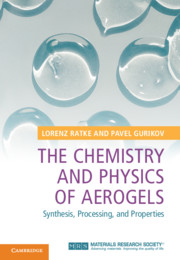Book contents
- Frontmatter
- Dedicatioin
- Contents
- Preface
- 1 Introduction
- 2 Chemical Synthesis of Aerogels from Monomeric Precursors
- 3 Chemical Synthesis of Aerogels from Polymeric Precursors
- 4 Gelation
- 5 Drying of Wet Gels
- 6 Morphology of Aerogels
- 7 Density: Models and Measures
- 8 Specific Surface Area
- 9 Pores and Pore Sizes
- 10 Diffusion in Aerogels
- 11 Permeability for Gases
- 12 Thermal Properties
- 13 Mechanical Properties of Aerogels
- 14 How to Cook Aerogels: Recipes and Procedures
- Appendix A Thermodynamics and Phase Separation in Immiscibles
- Appendix B Flory–Huggins Theory of Polymer Solutions
- Appendix C A Brief Review on Scattering
- Appendix D Mathematics of Polycondensation
- Appendix E Time-Dependent Heat Transfer through an Isolated Tube
- References
- Index
9 - Pores and Pore Sizes
Published online by Cambridge University Press: 03 December 2021
- Frontmatter
- Dedicatioin
- Contents
- Preface
- 1 Introduction
- 2 Chemical Synthesis of Aerogels from Monomeric Precursors
- 3 Chemical Synthesis of Aerogels from Polymeric Precursors
- 4 Gelation
- 5 Drying of Wet Gels
- 6 Morphology of Aerogels
- 7 Density: Models and Measures
- 8 Specific Surface Area
- 9 Pores and Pore Sizes
- 10 Diffusion in Aerogels
- 11 Permeability for Gases
- 12 Thermal Properties
- 13 Mechanical Properties of Aerogels
- 14 How to Cook Aerogels: Recipes and Procedures
- Appendix A Thermodynamics and Phase Separation in Immiscibles
- Appendix B Flory–Huggins Theory of Polymer Solutions
- Appendix C A Brief Review on Scattering
- Appendix D Mathematics of Polycondensation
- Appendix E Time-Dependent Heat Transfer through an Isolated Tube
- References
- Index
Summary
Pores are in aerogels essential. Experimentersoften usethe nitrogen adsorption measurement technique and derive from the desorption curve the pores' size distribution assuming cylindrical pores and the Kelvin equation to be applicable.A description of the pores is difficult and the situation is not comparable with, for instance, closed cell foams. Scanning electron microscopy gives an imagination of the particles or fibrils and thus also the pores. Nevertheless, there are simple measures for pore sizes possible, which are well defined in stereology, namely the mean free distance between particles or fibrils in a network and the next nearest neighbour distance. In addition, scattering methods allow us to extract chord lengths in pores and the solid phase assuming a suitable model of the two-phase structure. The experimental techniques such as the BJH model and thermoporosimetry are discussed and the basic equations derived. The theoretical models are compared with experimental results for different aerogels.
- Type
- Chapter
- Information
- The Chemistry and Physics of AerogelsSynthesis, Processing, and Properties, pp. 268 - 284Publisher: Cambridge University PressPrint publication year: 2021

